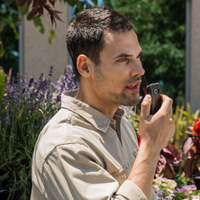


“You’ve just lost your attention of your surroundings, but with the Interceptor, it will pick up your voice evenly no matter where you talk.”įeaturing the same dual-link connectivity that can pair with both a two-way radio and a smartphone, the E2 provides hands-free PoC convenience in a headset. “When the microphone element is in front of the microphone, you actually have to tilt your head and talk down, which is tactically very unsafe,” said Scheimberg. The microphone element is situated on top of the microphone, instead of on the front by the speaker grill, allowing officers to talk in any direction and still be heard. Not only is the Interceptor a great choice for PoC communication but its design helps to keep officers safe while on duty. “That light will time out after 10 seconds so there’s no glow giving an officer away at night.” “Another great feature on the back of the microphone is the LED to let you know when you’re powered up and you’re paired to another device,” said Scheimberg. Those who need to be more discreet can plug an earpiece into the Interceptor’s 3.5 mm audio jack, and its lightweight design is both ergonomic in your hand and can clip onto a shirt without feeling heavy.

Similar to other Earphone Connection accessories, the Interceptor features two push-to-talk buttons yet hosts a wealth of other benefits that make it easy to communicate while on the job. Its large battery offers up to 20 hours of talk time, even when connected to two Bluetooth-enabled devices.
#PUSH TO TALK CELL PHONES BLUETOOTH#
Some equipment is ideal for day-to-day operations while other accessories might be better suited for specific tasks.ĭesigned for the ultimate level of convenience, the Interceptor is a Bluetooth speaker microphone that can be used with a two-way radio and a smartphone PoC app simultaneously. The PoC accessories available from Earphone Connection provide different options to meet individual officer preferences. The real heroes of this technology, however, are the accessories that enhance the benefits that push-to-talk can provide. PoC communication can assist agencies in many scenarios where relying only on LMR may result in a subpar outcome. Officers can connect wired headphones to the phone in their pocket and, through a push-to-talk app, communicate with multiple individuals while maintaining their cover. The discreet nature of cell phones featuring PoC capabilities also comes in handy during plainclothes operations. For example, officers can communicate with others on-site using encrypted land mobile radio while those off-site can be reached via cell at the touch of a button. Push-to-talk technology can be useful for day-to-day operations, however, officers often find that using both LMR and PoC during emergencies offers the best combination of effective and efficient response. Yet those who have integrated PoC into their department have found this method of communication can be truly beneficial.

Those in law enforcement are sometimes hesitant to adopt new technology, particularly when proven systems like LMR have their advantages. In addition, those who are bringing PoC technology into their department find that the accessories designed by Earphone Connection bring an extra level of convenience and help to complete their push-to-talk set-up. But what if you could keep your phone in your pocket, talk via a push-to-talk button on a microphone and achieve the same thing?” said Ruben Scheimberg, owner of Earphone Connection.įor over 20 years, Earphone Connection has provided law enforcement agencies with communication equipment that offers efficiency, safety and reliability. “PoC is the convenience to talk to a whole team with one button. Even so, some find themselves wishing that some aspects of PoC were a little more user-friendly. Law enforcement agencies have implemented PoC in several ways, with some using specific PoC phones and others opting for push-to-talk apps installed on department-issued mobile phones.Īs more officers have seen how LMR and PoC technology complement each other, the demand for push-to-talk communication has taken off in recent years. Intended as a complimentary communication method to LMR, push-to-talk or push-to-talk over cellular (PoC) uses the same technology that all of us have come to rely on daily with our personal cellular devices. As more officers have seen how LMR and PoC technology complement each other, the demand for push-to-talk communication has taken off in recent years.


 0 kommentar(er)
0 kommentar(er)
